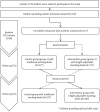Effects of Installing Height-Adjustable Standing Desks on Daily and Domain-Specific Duration of Standing, Sitting, and Stepping in 3rd Grade Primary School Children
- PMID: 32903373
- PMCID: PMC7434830
- DOI: 10.3389/fpubh.2020.00396
Effects of Installing Height-Adjustable Standing Desks on Daily and Domain-Specific Duration of Standing, Sitting, and Stepping in 3rd Grade Primary School Children
Abstract
Background: Aim of this intervention study was to evaluate whether availability of standing desks in classrooms may reduce sitting time and enhance standing and stepping time during lessons and breaks. Further, we evaluated if differences in standing desk use differed by physical fitness (PF) levels of children. Methods: To assess sitting, standing and stepping during a typical school week in 3rd grade primary school children (N = 52), activPAL monitors were used at baseline: T0, 1st follow-up: T1 and 2nd follow-up: T2. At baseline, PF was measured using the standing long jump and the 6-min jog-walk to assign children as having low PF (LPF) or high PF (HPF). Standing desks were assigned randomly to intervention and control groups at T1 (group 1) and T2 (group 2) with a cross-over design. Changes of sitting, standing and stepping were analyzed to investigate intervention effects at follow-up, using linear mixed models. Results: At baseline, children spent about 60 and 30% of time sitting during lessons and breaks, respectively. After installing standing desks (T1), significantly lower proportions of sitting were observed in the intervention group 1 [-13.1%, 95%-CI: (-20.5; -5.72)] and the control group 2 [-9.78%, 95%-CI: (-17.3; -2.28)]. Compared to the baseline measurement (T0), lower proportions of sitting were particularly expressed during school breaks in group 1 and 2 after intervention in T1 [group 1: -10.3%, 95%-CI: (-16.4; -4.25)] or in T2 [group 2: -8.59%, 95%-CI: (-15.2; -1.94)]. In general, children with higher physical fitness were less sedentary and more active, but intervention effects did not differ by fitness levels. Conclusion: Standing desks provide an opportunity to reduce sedentary time during lessons and breaks at school in primary school children, but do not directly increase PA of high intensity such as stepping. Future studies should consider potential bandwagon effects caused by structural interventions.
Keywords: breaks; leisure time activity; lessons; objective measurement; physical fitness.
Copyright © 2020 Sprengeler, Hebestreit, Gohres, Bucksch and Buck.
Figures
Similar articles
-
Stand Out in Class: Investigating the Potential Impact of a Sit-Stand Desk Intervention on Children's Sitting and Physical Activity during Class Time and after School.Int J Environ Res Public Health. 2021 Apr 29;18(9):4759. doi: 10.3390/ijerph18094759. Int J Environ Res Public Health. 2021. PMID: 33946984 Free PMC article. Clinical Trial.
-
The impact of height-adjustable desks and classroom prompts on classroom sitting time, social, and motivational factors among adolescents.J Sport Health Sci. 2023 Jan;12(1):97-105. doi: 10.1016/j.jshs.2020.05.002. Epub 2020 May 20. J Sport Health Sci. 2023. PMID: 32445902 Free PMC article.
-
Impact of an 8-Month Trial Using Height-Adjustable Desks on Children's Classroom Sitting Patterns and Markers of Cardio-Metabolic and Musculoskeletal Health.Int J Environ Res Public Health. 2016 Dec 10;13(12):1227. doi: 10.3390/ijerph13121227. Int J Environ Res Public Health. 2016. PMID: 27973414 Free PMC article. Clinical Trial.
-
The effects of standing desks within the school classroom: A systematic review.Prev Med Rep. 2016 Apr 9;3:338-47. doi: 10.1016/j.pmedr.2016.03.016. eCollection 2016 Jun. Prev Med Rep. 2016. PMID: 27419034 Free PMC article. Review.
-
Workplace interventions for increasing standing or walking for decreasing musculoskeletal symptoms in sedentary workers.Cochrane Database Syst Rev. 2019 Nov 17;2019(11):CD012487. doi: 10.1002/14651858.CD012487.pub2. Cochrane Database Syst Rev. 2019. PMID: 31742666 Free PMC article.
Cited by
-
The Effectiveness of Interventions to Reduce Sedentary Time in Different Target Groups and Settings in Germany: Systematic Review, Meta-Analysis and Recommendations on Interventions.Int J Environ Res Public Health. 2022 Aug 17;19(16):10178. doi: 10.3390/ijerph191610178. Int J Environ Res Public Health. 2022. PMID: 36011821 Free PMC article.
-
Effects of flexible learning spaces, active breaks, and active lessons on sedentary behaviors, physical activity, learning, and musculoskeletal health in school-aged children: a scoping review.J Act Sedentary Sleep Behav. 2024 Dec 2;3(1):30. doi: 10.1186/s44167-024-00068-2. J Act Sedentary Sleep Behav. 2024. PMID: 40217446 Free PMC article. Review.
-
Stand Out in Class: Investigating the Potential Impact of a Sit-Stand Desk Intervention on Children's Sitting and Physical Activity during Class Time and after School.Int J Environ Res Public Health. 2021 Apr 29;18(9):4759. doi: 10.3390/ijerph18094759. Int J Environ Res Public Health. 2021. PMID: 33946984 Free PMC article. Clinical Trial.
-
Effects of Classroom Active Desks on Children and Adolescents' Physical Activity, Sedentary Behavior, Academic Achievements and Overall Health: A Systematic Review.Int J Environ Res Public Health. 2021 Mar 10;18(6):2828. doi: 10.3390/ijerph18062828. Int J Environ Res Public Health. 2021. PMID: 33802133 Free PMC article.
References
-
- WHO Global Recommendations on Physical Activity for Health. Geneva: World Health Organization; (2010). - PubMed
Publication types
MeSH terms
LinkOut - more resources
Full Text Sources
Medical


